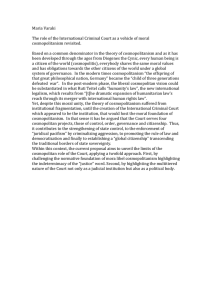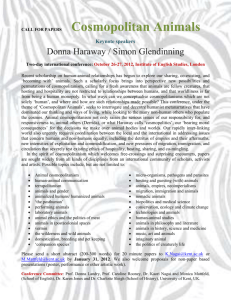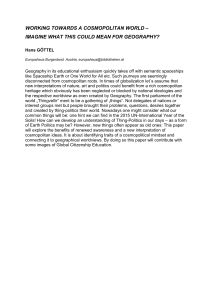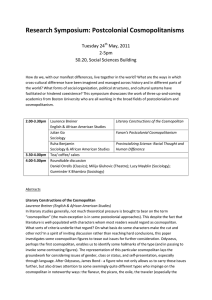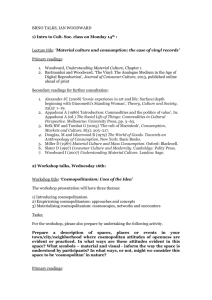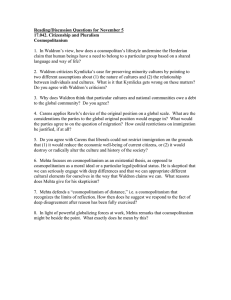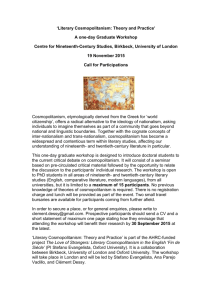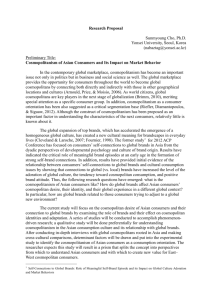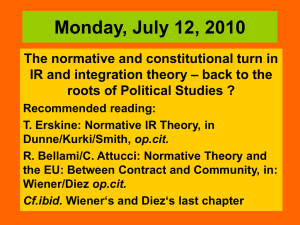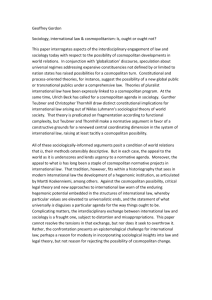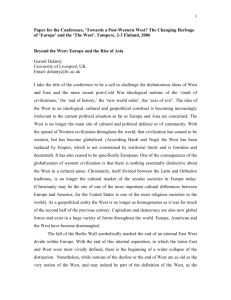Understanding 'cosmopolitan practices'
advertisement
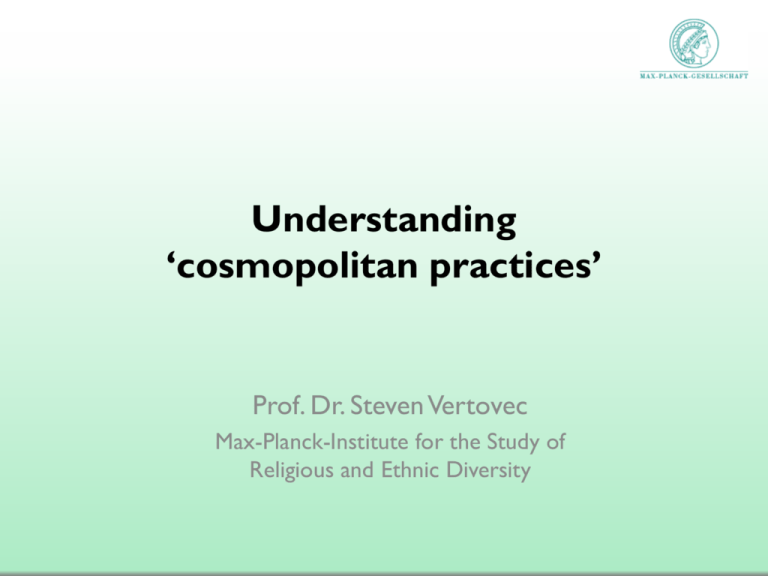
Understanding ‘cosmopolitan practices’ Prof. Dr. Steven Vertovec Max-Planck-Institute for the Study of Religious and Ethnic Diversity Understanding ‘cosmopolitan practices’ 1. 2. 3. 4. 5. Varieties of cosmopolitanism Attitudes and practices Some examples: the Coopers vs. Stavros Some possible mechanisms/processes So what? Cosmopolitanism as… (1) Socio-Cultural Condition (2) Philosophy or World-view (3) Political Project I: Transnational Institutions (4) Political Project II: Multiple Subjects (5) Attitude or Disposition (6) Practice or Competence Cosmopolitanism as attitude • Hannerz (1996: 103) – ‘…an orientation, a willingness to engage with the other. …an intellectual and aesthetic openness toward divergent cultural experiences….’ • Van der Veer (2002) – yet on what terms? Cf. colonial officers, missionaries Cosmopolitanism as practice: doing what? Hannerz (1990) cosmopolitanism as • ‘…a personal ability to make one’s way into other cultures through listening, looking, intuiting and reflecting’ • ‘cultural competence… a built-up skill in maneuvering more or less expertly with a particular system of meanings and meaningful forms’ • ‘a mode of managing meaning’ Cosmopolitan Practice: as consumption? • • • • • ‘ethnic’ designs ‘ethnic’ furnishings ‘ethnic’ food ‘world’ music tourism - ‘home-plus’ exotic - not really ‘making way into another culture’ or meaning system? Cosmopolitanism as practice: doing what? • ‘Cultural navigation’ • Reading, engaging, performing actions/reactions, utterances, behaviours • When in Rome, do as the Romans do… • Acts/signals of and for communication – Mutual understanding, common meaning • For pleasure, ease, advantage, distinction or survival? Cosmopolitan Practice as ‘doing’: by whom? • Growing literature on: ‘…x cosmopolitanism’ – ‘actually existing’ – ‘everyday’ – ‘vernacular’ – ‘ordinary’ – ‘practical’ – ‘tactical’ • To distinguish from elite, jet-set Cosmopolitanism BBC ‘Goodness Gracious Me’ The Coopers (Kapoors) and the Robinsons (Rabindaraths) Cosmopolitan practice as wolf-in-sheep’s clothing • Conscious • Knowledge-based to demonstrate right thing to do (‘I knew that’) • Purposeful / ‘tactical’ in order to mark social inclusion / distinction Harry Enfield Stavros Cosmopolitan practice as cultural chameleon • Non-conscious • Not about knowledge but subtle communication cues of commonality (‘innit’, ‘or what’, ‘mate’) • Not wanting anything except shared meaning Mechanisms for cosmopolitan practices? 1. Linguistic analogy • Cosmopolitanism like bi-/multi-lingualism? – Emphasis on communication: grammar, syntax, lexicon • Code-switching Berlin sei eben "the place to be", erklärt ein Banker... – Structural equivalents, social contexts, motivations? – Conscious or non-conscious? (cf. Stavros) – Related to language dominance? • Crossing – momentary, ritualized instances of outgroup language use to move across social or ethnic boundaries • Pidgin and creole / creolization Mechanisms for cosmopolitan practices? 2. Reading/enacting scripts • Roger Schank: scripts – sets of semantic memories stored, allow individual to make inferences to fill in missing information • Social scripts: adaptable to contexts – E.g. , going to restaurant • Capacity for pattern recognition Mechanisms for cosmopolitan practices? 3. Multiple-cultural competence • Swidler (1986): culture-as-toolkit, set of resources; ‘all people know more culture than they use’ (p. 277) • Bourdieu (1977): practical improvising from repertoire of ‘dispositions’ (acquired schemes of perception, thought and action) • Caglar (1994): not unlimited; embedded, conditional • Refutes ‘between two cultures’ presumption All begs question: what is (cultural) difference? To adopt ‘cosmopolitan practices’, • What are borders/fault lines that have to be crossed? • What is ‘package’ of meaning-carrying traits that has to be read, engaged, performed? • Relevant to class, locality, gender, religion, age, sexuality, ‘sub-culture’ or ‘scene’… Can cosmopolitan competence be taught / fostered / instilled? • ‘inter-cultural competence’ courses • Public campaigns • Creating spaces/events for interaction Spaces of ‘contact’ • Workplaces, schools, markets, leisure • SocPsych: ‘contact’ indeed reduces prejudice • Cosmo. Practices? multiple cultural competence – or 3rd modalities: civility, pidgin, creole Instilling cosmopolitanism • • • • • Knowledge? Appreciation? Empathy? ‘Tolerance’? Hannerz (1990: 239) cosmo. as ‘cultural competence… a built-up skill in maneuvering more or less expertly with a particular system of meanings and meaningful forms’ Max-Planck-Institute for the Study of Religious and Ethnic Diversity Max-Planck-Institut zur Erforschung multireligiöser und multiethnischer Gesellschaften Hermann-Föge-Weg 11, D-37073 Göttingen, Germany tel. +49/0 551 4956-0, fax +49/0 551 4956-111 www.mmg.mpg.de
